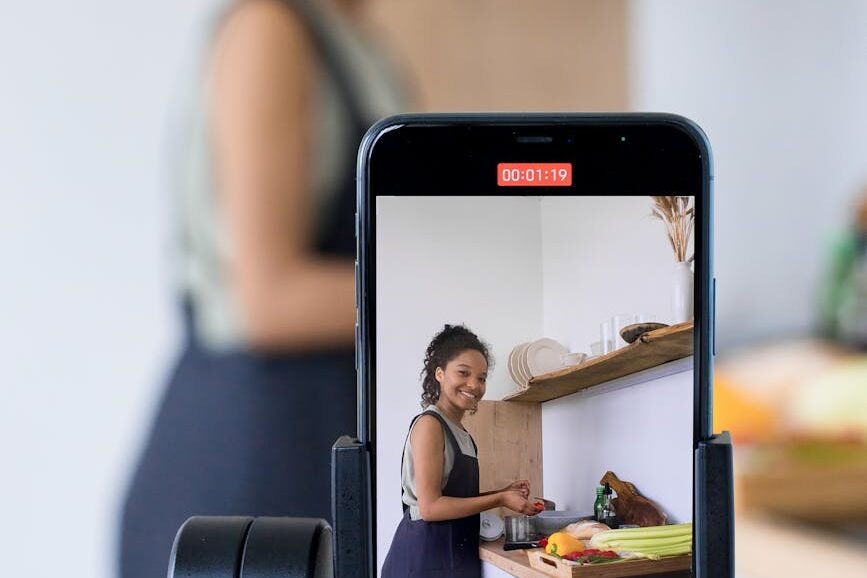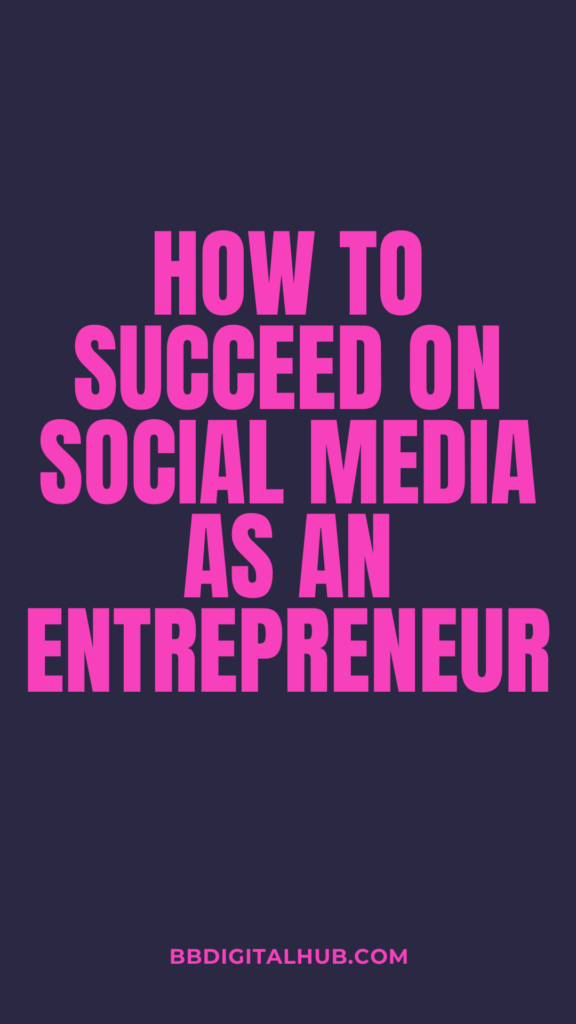Your cart is currently empty!
How to Succeed on Social Media as an Entrepreneur
•
This page may contain affiliate links. If you follow a link to sign up or make a purchase, I’ll earn a small commission at no cost to you.

Let’s be honest with ourselves: social media is not what it used to be.
Once people clocked that you can make money on social media, the game changed.
Some people love it, and some hate it. But one thing is certain: to grow your business, you need social media.
At least to some degree.
But don’t be fooled into thinking you just need to post some nice pictures, and your audience will come running.
Nah, that’s social media circa 2014.
Now, you need a strategy, a schedule, and, most of all, patience……. lots of patience.
But the payoff is 100% worth it.
So, if you want your business to be seen, remembered, and trusted, you need to show up on social media.
In this blog post, you’ll learn what to do if you want success on social media as an entrepreneur.
1. Know Your “Why” and Brand Story

Before you post anything, before you even pick a platform, you need to ask yourself:
‘Why did I start this business?’
What’s the story behind it? What problem does it solve? Who does it help? How do you want people to see your business?
I know it’s a lot of questions, but this is foundational. To stand out and truly connect with people online, you need to know your business inside and out.
For example, My story is that I started BBDIGITALHUB because I experienced firsthand how confusing and overwhelming marketing, specifically content marketing, can be for beginners.
Everything I learned about marketing, I learned myself, and it wasn’t that easy. I wanted to change this for others. I didn’t want other entrepreneurs to feel as confused as I did, so I created this space.
This is a space where entrepreneurs can learn the marketing skills and tools they need to promote and grow their businesses.
That’s my brand’s story.
Your brand story is what everything else is built on.
The businesses killing it on social media today aren’t just pushing their products 24/7.
They’re constantly telling their story, their mission, their values. They get creative with how they show up.
They sell their why, not just their what. That’s what pulls people in.
So ask yourself: What is my business’s story, and am I telling it well?
2. Do Your Research
You know that phrase: “Know thy enemy”?
It applies here………well, except your competitors aren’t your enemies.
But you get the point.
Before you start creating content, study the playing field. Pick 3–5 direct competitors and dig into their social platforms.
- What kind of content do they post?
- What seems to perform well?
- How does their audience interact with them?
- What hooks do they use? What topics do they avoid?
- Is there a common format or theme everyone follows in your industry?
- What’s missing? What could be done better?
Read the comments. See what people are loving (and complaining about).
This is valuable insight most entrepreneurs skip over. But knowledge is power. Use what you learn to shape a strategy that’s informed, intentional, and tailored to your niche.
Just don’t overconsume to the point of paralysis. The goal here is not to copy anyone, it’s to learn, adapt, and make it your own.
3. Understand the Social Platforms

Not all platforms are created equal, and not every platform is for you.
For example, X (Twitter), I know other marketers who work well on that platform, but I know myself and my business enough to know that that specific platform isn’t for me, personally.
I love Pinterest, I swear by it. But I know other entrepreneurs that can’t stand it.
So, research the platforms you’re thinking about joining. Ask yourself:
- Is my audience active here?
- What kind of content performs best on this platform?
- Do people prefer polished content or raw, unfiltered moments?
- Is text-based content king, or is it all about video?
- Are carousels or single images more effective?
- What are the unspoken “rules” of this platform?
For example, what works well on TikTok might totally flop on LinkedIn. It’s not just about jumping on trends, it’s about aligning your content with the expectations of the platform and your audience.
Follow successful creators on the platforms you’re interested in and observe what they do. (Again, observe, don’t copy.)
Take notes.
Test things out.
Tweak as you go.
4. Get Comfortable in Front of the Camera

If you’re an entrepreneur, you can’t afford to be camera-shy.
I get it, it’s awkward, it’s scary, and putting yourself out there can feel cringey. Trust me, I’ve been there (and still feel this way sometimes).
In fact, I’ve openly talked about my struggles on Instagram.
But here’s the harsh truth: Visibility pays.
In today’s world, visibility is currency. The people who are consistently showing up online are the ones getting the brand deals, collaborations, exposure, and sales.
They’re not necessarily the best at what they do, they’re just the ones being seen.
You need to be your business’s biggest advocate. You need to promote your brand like no one else will—because no one else will.
It starts with showing your face, telling your story, and letting people connect with you.
Yes, your friends and family might see you. Yes, you might be judged. Yes, it might feel awkward.
Do it anyway.
Every successful creator you follow once felt exactly like you do right now, they just didn’t let it stop them.
Start small.
Show a little more of yourself with each post. Let people in. Forget perfection. Be real. That’s what people are drawn to.
(And yes, shameless plug, follow me @bbdigitalhub on Instagram. Let’s grow together.)
5. Figure Out How to Relate to Your Audience
If there’s one thing that separates successful brands from the rest, it’s this: they know how to relate to their audience.
And I know you’ve heard it a million times, but it’s true: people buy from people. People they trust. People they see themselves in.
You want your audience to feel like you get them and that you understand their problems, struggles, dreams, and goals.
That’s when they start paying attention. That’s when they stick around.
To relate to your audience, you have to know them inside and out:
- What do they want?
- What’s holding them back?
- What keeps them up at night?
- What would success look like for them?
Then, position your business as the solution. Make your content reflect that.
Make them feel seen. Let them know you’ve been where they are and that you can help them get to where they want to be.
Learn how to create content that relates to your audience.
6. Learn to Tell Stories

This one’s big.
People remember stories way more than they remember stats, features, or benefits.
Stories build connection. They make people feel something. That’s what builds trust, and trust leads to sales.
So, instead of just saying, “My product does XYZ,” tell the story behind why you created it.
Talk about the problem you faced. The solution you found. The transformation you experienced or helped someone else experience.
Every post doesn’t need to be a deep, emotional story. But even light, everyday content can tell a story.
Just think: What’s the message here? What am I really trying to say?
7. Learn How to Sell (Without Feeling Weird About It)
Selling doesn’t have to feel pushy or slimy. In fact, the best kind of selling doesn’t even feel like selling.
You can sell explicitly (“Here’s my offer, go buy it”) and implicitly (“Here’s how I solved this problem… and by the way, my product helped”).
Do both.
Mix it up.
Don’t be afraid to promote yourself, you’re running a business, after all.
But always remember: people don’t just buy products, they buy outcomes.
They buy transformations. They buy solutions.
Make your content reflect that.
Read this if you want to learn how to sell using your Instagram story.
8. Focus on Building a Community
Sometimes people forget the main purpose of social media.
It’s to be…….wait for it…….SOCIAL!
When your audience talks to you, talk back.
Talk to competitors in your industry and to other entrepreneurs in related industries.
My point is: TALK! (sorry if this reads like I’m yelling, I promise I’m not)
You build a community by having conversations.
Social media isn’t just a content distribution platform. It’s a place to build a community around your brand.
The goal isn’t just to promote your business and go viral, it’s to create connection.
Talk to your audience. Ask questions. Respond to comments and DMs. Make people feel like they matter.
Because they do.
A loyal community will buy from you, advocate for you, and stick around even when things get tough. That’s where long-term success lives, not in likes but in loyalty.
Success on social media as an entrepreneur isn’t about being perfect or having the most aesthetic feed. It’s about showing up with purpose, telling your story, connecting with your people, and staying consistent.
You don’t need to go viral.
You don’t need to be on every platform.
You just need to start. Start small. Start messy. But start.
And remember, no one can market your business better than you can.

Join Our Community Today
Get exclusive access to straightforward marketing strategies tailored for beginners.
Comments
One response to “How to Succeed on Social Media as an Entrepreneur”
-
[…] you come across a brand on social media, via email, or on Google, what catches your […]

Leave a Reply